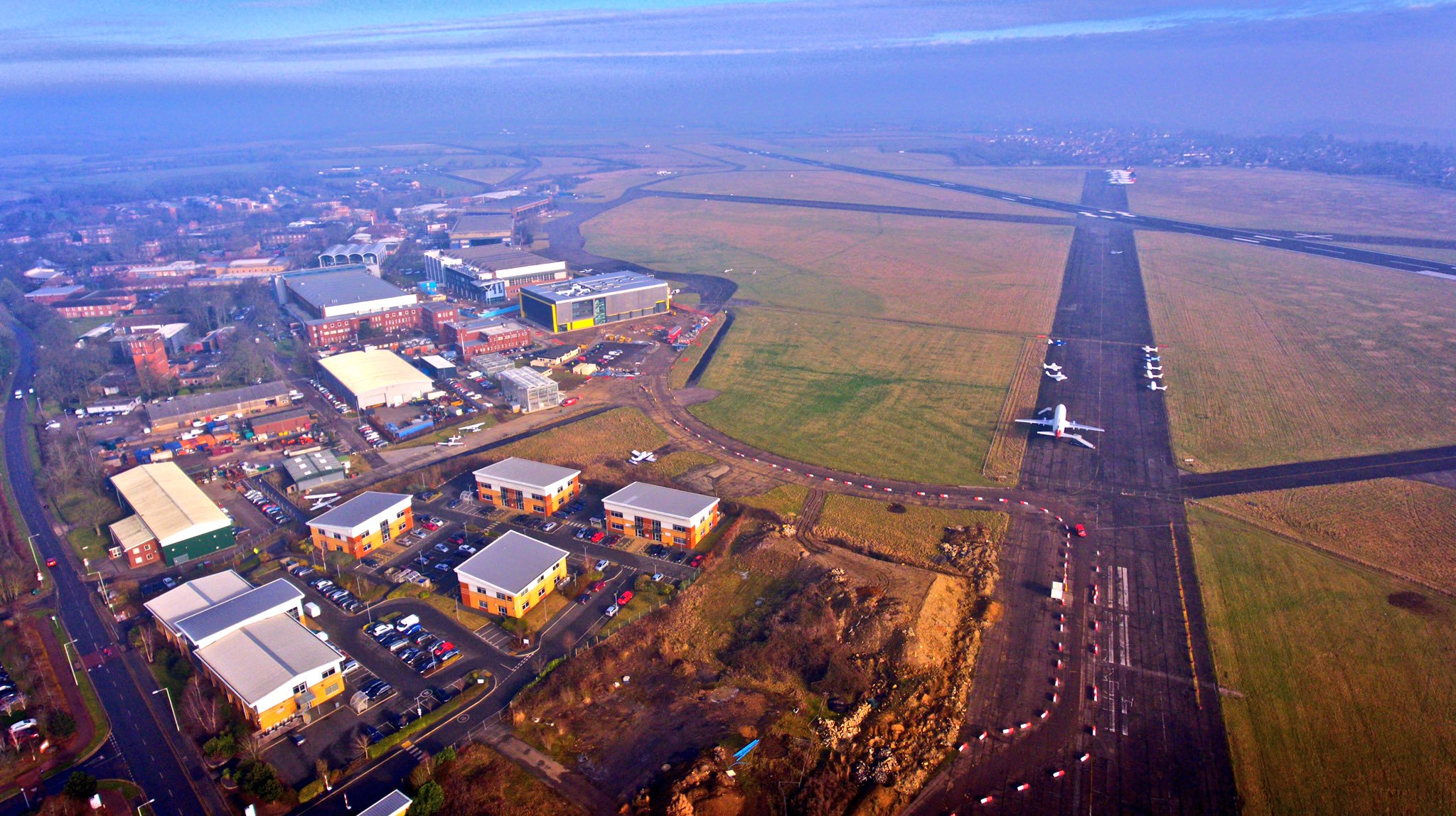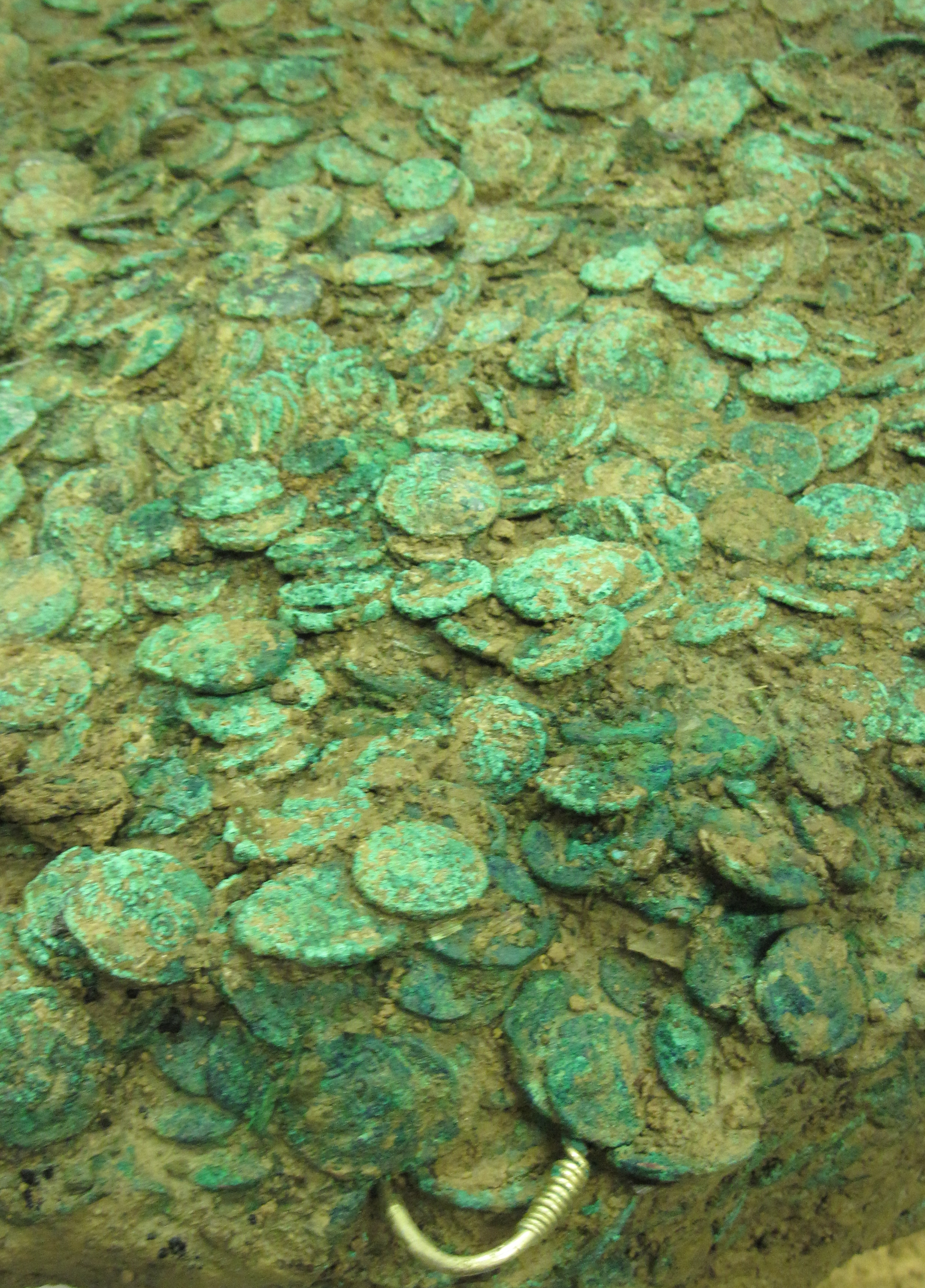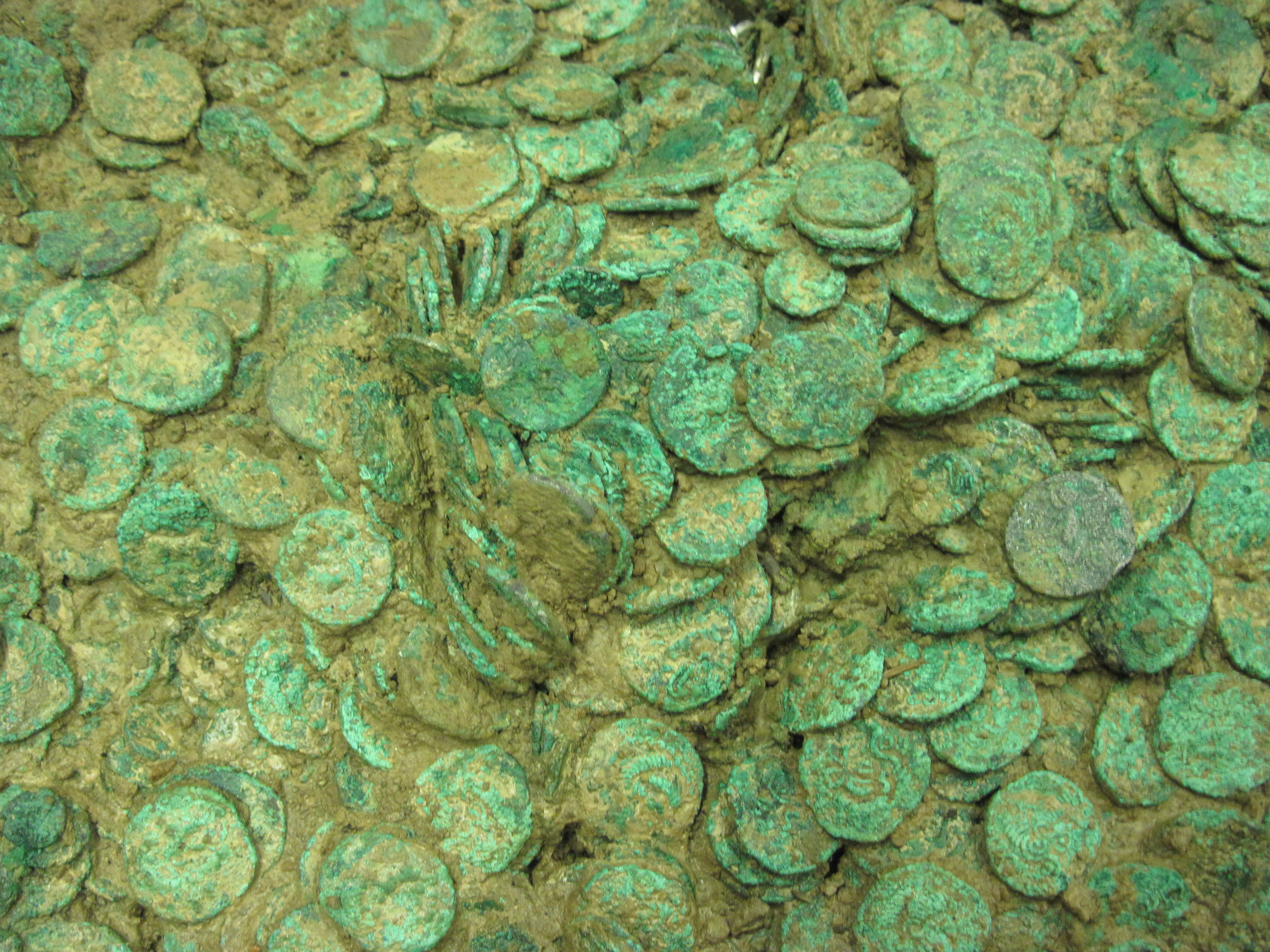|
Trinity Hoard
Trinity Hoard is a collection of Bronze Age items, including 23 bronze axeheads, found in Jersey in 2012. Find and study The hoard of late Bronze Age (around 1,000 BCE) items was found inside a pottery container, about 30 cm underground, in October 2012, by metal detectorist Ken Rive, in the Parish of Trinity in the north of Jersey. A conservator from Jersey Heritage was able to attend at the find before digging began. The container was around 30 cm across. It had been damaged, probably by a plough, which had freed the two axeheads. There was other material at the site, including pieces of broken pottery not from the primary find. Initially, only two socketed axeheads were identified, but after scanning by an X-ray scanner at Jersey Airport, a further 21 axeheads, at least, were seen to be present in the pot. The first two axeheads were subjected to an X-ray fluorescence scan at Cranfield University, which showed that the bronze alloy has a very high lead content (nea ... [...More Info...] [...Related Items...] OR: [Wikipedia] [Google] [Baidu] |
Bronze Age
The Bronze Age is a historic period, lasting approximately from 3300 BC to 1200 BC, characterized by the use of bronze, the presence of writing in some areas, and other early features of urban civilization. The Bronze Age is the second principal period of the three-age system proposed in 1836 by Christian Jürgensen Thomsen for classifying and studying ancient societies and history. An ancient civilization is deemed to be part of the Bronze Age because it either produced bronze by smelting its own copper and alloying it with tin, arsenic, or other metals, or traded other items for bronze from production areas elsewhere. Bronze is harder and more durable than the other metals available at the time, allowing Bronze Age civilizations to gain a technological advantage. While terrestrial iron is naturally abundant, the higher temperature required for smelting, , in addition to the greater difficulty of working with the metal, placed it out of reach of common use until the end o ... [...More Info...] [...Related Items...] OR: [Wikipedia] [Google] [Baidu] |
Jersey
Jersey ( , ; nrf, Jèrri, label=Jèrriais ), officially the Bailiwick of Jersey (french: Bailliage de Jersey, links=no; Jèrriais: ), is an island country and self-governing Crown Dependencies, Crown Dependency near the coast of north-west France. It is the largest of the Channel Islands and is from the Cotentin Peninsula in Normandy. The Bailiwick consists of the main island of Jersey and some surrounding uninhabited islands and rocks including Les Dirouilles, Écréhous, Les Écréhous, Minquiers, Les Minquiers, and Pierres de Lecq, Les Pierres de Lecq. Jersey was part of the Duchy of Normandy, whose dukes became kings of England from 1066. After Normandy was lost by the kings of England in the 13th century, and the ducal title surrendered to France, Jersey remained loyal to the The Crown, English Crown, though it never became part of the Kingdom of England. Jersey is a self-governing Parliamentary system, parliamentary democracy under a constitutional monarchy, with its ... [...More Info...] [...Related Items...] OR: [Wikipedia] [Google] [Baidu] |
Metal Detectorist
A metal detector is an instrument that detects the nearby presence of metal. Metal detectors are useful for finding metal objects on the surface, underground, and under water. The unit itself, consist of a control box, and an adjustable shaft, which holds a pickup coil, which can vary in shape and size. If the pickup coil comes near a piece of metal, the control box will register its presence by a changing tone, a flashing light, and or by a needle moving on an indicator. Usually the device gives some indication of distance; the closer the metal is, the higher the tone in the earphone or the higher the needle goes. Another common type are stationary "walk through" metal detectors used at access points in prisons, courthouses, airports and psychiatric hospitals to detect concealed metal weapons on a person's body. The simplest form of a metal detector consists of an oscillator producing an alternating current that passes through a coil producing an alternating magnetic field. I ... [...More Info...] [...Related Items...] OR: [Wikipedia] [Google] [Baidu] |
Trinity, Jersey
Trinity (french: La Trinité, Jèrriais: ''La Trinneté'') is one of the twelve parishes of Jersey in the Channel Islands. It is north of St Helier. It has a population of 3,156.''Portrait of the Channel Islands'', Raoul Lemprière, 1970 The parish covers 6,975 vergées (). Les Platons in the north of the parish is the highest point in Jersey. The parish borders St John, St Helier, St Saviour and St Martin. Trinity is an agricultural, rural parish, with only 16% of the parish being built-up, and 61% dedicated to cultivation. The population is generally spread out across the whole parish, with a loosely defined village towards the north of the parish. The parish's main bay is Bouley Bay, a short distance from the village. A section of Rozel Bay is also shared with neighbouring St Martin. It is home to the States Farm, Jersey Zoo, the Royal Jersey Agricultural and Horticultural Society Showground, and the Pallot Heritage Steam Museum. The parish church is dedicated to the Holy Tr ... [...More Info...] [...Related Items...] OR: [Wikipedia] [Google] [Baidu] |
Jersey Airport
Jersey Airport is an international airport located in the parish of Saint Peter, west northwest of Saint Helier in Jersey, in the Channel Islands. History Air service to Jersey before 1937 consisted of biplane airliners and some seaplanes landing on the beach at Saint Aubin's bay. Jersey Airways and Imperial Airways were among those who operated to the island before the Second World War, but conditions were difficult as tides governed timetables. It was also difficult to prevent public members from walking across the landing area, and any aircraft that had mechanical problems had to be dragged up the slipways until the tide receded. The States of Jersey decided to build an airport which opened on with four grass runways, the longest being with a concrete centreline. Concrete taxiways were added during the World War II occupation by the Luftwaffe – they also built hangars, one of which, the Jersey Airlines hangar, is still in existence although no longer used. A tarmac ... [...More Info...] [...Related Items...] OR: [Wikipedia] [Google] [Baidu] |
Hallmark
A hallmark is an official mark or series of marks struck on items made of metal, mostly to certify the content of noble metals—such as platinum, gold, silver and in some nations, palladium. In a more general sense, the term ''hallmark'' can also be used to refer to any distinguishing mark. General overview Historically, hallmarks were applied by a trusted party: the "guardians of the craft" or, more recently, by an assay office. Hallmarks are a guarantee of certain purity or fineness of the metal, as determined by official metal (assay) testing. Distinguishment Hallmarks are often confused with "trademarks" or "maker's marks". A hallmark is not the mark of a manufacturer to distinguish their products from other manufacturers' products: that is the function of trademarks or makers' marks. To be a true hallmark, it must be the guarantee of an independent body or authority that the contents are as marked. Thus, a stamp of "925" by itself is not, strictly speaking, a hallmark, b ... [...More Info...] [...Related Items...] OR: [Wikipedia] [Google] [Baidu] |
Cranfield University
, mottoeng = After clouds light , established = 1946 - College of Aeronautics 1969 - Cranfield Institute of Technology (gained university status by royal charter) 1993 - Cranfield University (adopted current name) , type = Public research university , chancellor = Dame Deirdre Hutton , vice_chancellor = Karen Holford , administrative_staff = 1,800 , students = ()(all postgraduates) , undergrad = , postgrad = , city = Cranfield, BedfordshireShrivenham, OxfordshireEngland , campus = Rural (both) , former_names = Cranfield Institute of TechnologyCollege of Aeronautics , colours = , athletics = , affiliations = ACUPEGASUSEQUISAACSBAMBA M5 UniversitiesUniversities UK , website = https://www.cranfield.ac.uk/ , logo = , footnotes = Cranfield University is a British postgraduate public research university specialising in science, engineering, design, technology and management. Cranfield was founded as the College of Aeronautics (CoA) in 1946. Through the 195 ... [...More Info...] [...Related Items...] OR: [Wikipedia] [Google] [Baidu] |
Grouville Hoard
The Grouville Hoard is a hoard of an estimated 70,000 late Iron Age and Roman coins reported in June 2012. They were discovered by metal detectorists Reg Mead and Richard Miles in a field at an undisclosed location in the parish of Grouville on the east side of Jersey in the Channel Islands. It is the largest hoard ever found in Jersey, and the first major archaeological find made by metal detectorists in the island. The hoard is thought to have belonged to a Curiosolitae tribe fleeing Julius Caesar's armies around 50 to 60 BC. The find was the subject of a BBC Radio 4 programme in November 2021. Discovery Mead and Miles started metal detecting in the area where the hoard was reported in the early 1980s after they heard about a farmer who some years earlier had discovered a number of silver coins in an earthenware pot while pulling out a tree from a hedgerow. However, as they did not know the exact location of the find, and as the current owner of the farm would only allow the ... [...More Info...] [...Related Items...] OR: [Wikipedia] [Google] [Baidu] |
List Of Hoards In The Channel Islands
The list of hoards in the Channel Islands comprises significant archaeological hoards of coins, jewellery, precious and scrap metal objects and other valuable items discovered in the Channel Islands (Jersey, Guernsey, Alderney, Sark, Herm and associated smaller islands). It includes both hoards that were buried with the intention of retrieval at a later date (personal hoards, founder's hoards, merchant's hoards, and hoards of loot), and also hoards of votive offerings which were not intended to be recovered at a later date, but excludes grave goods and single items found in isolation. The list is subdivided into sections according to archaeological and historical periods. At least fifteen hoards have been found in the Channel Islands since the early 18th century, most of them in Jersey, and only one each in Guernsey, Alderney and Sark. Of the known hoards, about a third date to the Bronze Age and are mostly founder's hoards comprising broken tools, weapons and other scrap me ... [...More Info...] [...Related Items...] OR: [Wikipedia] [Google] [Baidu] |
Archaeological Sites In Jersey
Archaeology or archeology is the scientific study of human activity through the recovery and analysis of material culture. The archaeological record consists of artifacts, architecture, biofacts or ecofacts, sites, and cultural landscapes. Archaeology can be considered both a social science and a branch of the humanities. It is usually considered an independent academic discipline, but may also be classified as part of anthropology (in North America – the four-field approach), history or geography. Archaeologists study human prehistory and history, from the development of the first stone tools at Lomekwi in East Africa 3.3 million years ago up until recent decades. Archaeology is distinct from palaeontology, which is the study of fossil remains. Archaeology is particularly important for learning about prehistoric societies, for which, by definition, there are no written records. Prehistory includes over 99% of the human past, from the Paleolithic until the advent of ... [...More Info...] [...Related Items...] OR: [Wikipedia] [Google] [Baidu] |
Metal Detecting Finds In The Channel Islands
A metal (from Greek μέταλλον ''métallon'', "mine, quarry, metal") is a material that, when freshly prepared, polished, or fractured, shows a lustrous appearance, and conducts electricity and heat relatively well. Metals are typically ductile (can be drawn into wires) and malleable (they can be hammered into thin sheets). These properties are the result of the '' metallic bond'' between the atoms or molecules of the metal. A metal may be a chemical element such as iron; an alloy such as stainless steel; or a molecular compound such as polymeric sulfur nitride. In physics, a metal is generally regarded as any substance capable of conducting electricity at a temperature of absolute zero. Many elements and compounds that are not normally classified as metals become metallic under high pressures. For example, the nonmetal iodine gradually becomes a metal at a pressure of between 40 and 170 thousand times atmospheric pressure. Equally, some materials regarded a ... [...More Info...] [...Related Items...] OR: [Wikipedia] [Google] [Baidu] |








.jpg)
